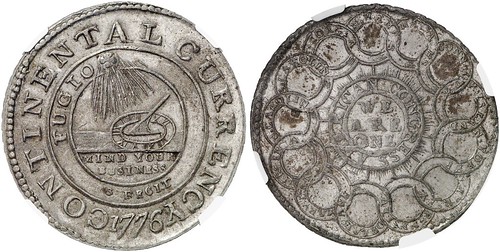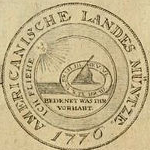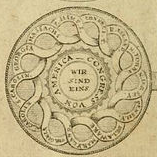
PREV ARTICLE
NEXT ARTICLE
FULL ISSUE
PREV FULL ISSUE
NOTES ON THE ORIGINS OF THE CONTINENTAL DOLLAR
In recent issues we've carried a thread on the origin of Continental Dollars. Last week I asked about the earliest known references to the coins.
-Editor

Bill Nyberg writes: In his book The Eagle That Is Forgotten: Pierre Eugene Du Simitiere, Founding Father of American Numismatics, author Dr. Joel Orosz quotes Du Simitiere, “a Coin…with devices and mottos taken from the continental paper money, Struckt in London on Type-Metal, and dated 1776.” The quote dates from sometime between 1783 to his death in October of 1784. Du Simitiere’s statement carries considerable weight, as he was deeply involved in artistic circles of America, and was a collector, researcher, and author of American numismatics. Wherever the 1776 dated Continental pieces were made, a substantial investment in capital and labor was required long before they were struck, including the design, fabrication, assembly, and set-up of a large screw press, rolling machinery, and a complex edge marking and upsetting machine. In his diary, Robert Morris describes a lengthy and difficult time to obtain “screws and rollers” for the 1783 United States pattern coins. The 1794 dollars were weakly struck because the large screw press would not be completed until months later. Also, the December 15, 1797 Act of Congress lengthened the effective date by six months for federal revenue stamps, because of the extensive time needed for Adam Eckfeldt to fabricate screw presses for the revenue stamps. All of this evidence indicates considerable time, cost, and technical skills were needed for the large Continental pieces. Could this have been done in America in 1776? It would be very beneficial to conduct a comprehensive edge die study on the Continental Dollars. The edge die designs could possibly provide positive links to contemporary medals, tokens, or coins in Great Britain or other countries. Bill Eckberg writes: Eric Newman, 1952. "The 1776 Continental Currency Coinage". Coin Collector’s Journal. 19 #4. The description of this article in the back of Truth Seeker is accurate. It says the coins exist (they do), “but the journals of the Continental Congress are silent as to official authorization for such coinage. Newman provides indirect [my italics] evidence that the Continental Congress planned for a $1 coin to replace the $1 paper currency note in about July 1776." Whichever of the authors did the annotated bibliography, unlike many catalogers over the past 65 years, was very careful not to overstate what Eric wrote. Eric Newman and Maureen Levine. 2014. "18th century writings on the Continental Currency dollar coin". Numismatist 127, 34-57. This article pushes the first recorded appearance of the coins (with the inscriptions in German!) to late 1783 in an article that also illustrated the Libertas Americana medal. They also report a vague satirical reference to “pewter dollars” from 1779, but what this refers to, if anything at all, is unknown.


The 1783 illustration was discussed in last week's article.
Bill Eckberg adds a note about his observations in his Sepember 2015 Coin World article, "Shady Stories for U.S. Coins."
-Editor
Bill Eckberg adds:
On the more general topic of numismatic research and writing, Bill Eckberg offers this: I wanted to mention one of my favorite terms from Harry Salyards. He calls it “History Past Subjunctive.” E.g., “certainly they would have done,” “Surely he would have thought,” etc. Unfortunately, there is a lot of this in numismatic writing. One of the reasons I loved the 1792: Birth of a Nation's Coinage book so much is that there is none of that crap in it. They speculate occasionally, but when they do, they say that’s what they’re doing.
Now, I would agree with Bill Nyberg that Du Simitiere’s statement carries considerable weight, but we do want to be careful not to jump to the conclusion that "surely it must be true". But it is a clue.
For more background I reached out to author Joel Orosz, who adds these observations. -Editor How much weight should we attach to Du Simitiere's (DS for short) statement that Continental Dollars were struck in London? DS was a voracious collector of both objects and information. Many Revolutionary-era pamphlets exist today only because he collected and saved a copy. DS also was a citizen of the world. As a Swiss national, he was neither a patriot nor a loyalist. As a man who was barely scraping by in the colonies, he couldn't afford ideogical purity; he would work with anyone who paid him, or had objects to donate to his museum. So could he have done business with a Briton who had first-hand knowledge of where Continental Dollars were struck? Absolutely! There is a record of DS doing numismatic business with a British officer, Major Thomas James of the Second Batallion of the Royal Artillery. in fact, as of 1768, the Major commanded all of His Majesty's artillery in Britain's North American provinces. (Kudos to Erik Goldstein, curator at Colonial Williamsburg, for identifying the Major's full name and duty posting, for he is only "Major James" in DS's records). Clearly, DS was glad to "talk coins" with British collectors. Therefore, the DS statement about Continental Dollars that Bill Nyberg rediscovered must be taken seriously as evidence in this matter, for it could represent informed contemporary knowledge that DS transcribed. It should not, however, be regarded as definitive. DS recorded a great deal of information he gleaned from sources whose reliability was all over the landscape. This could also have represented contemporary groundless speculation that DS recorded. We know more about the subject today, but when it comes to the big questions of when and where the Continental Dollars were struck, we are right back to where Eric Newman was in 1952 when he wrote "The 1776 Continental Currency Coinage" for the Coin Collector's Journal. To answer Bill Eckberg's question, I was the co-author who wrote Truth Seeker's annotated bibliography of Eric's publications, and I was careful to respect Eric's precise handling of the evidence. Neither Eric--nor anyone else, as of yet--has found unequivocal evidence that would settle these questions. So we are left with coins that could have been struck in England or in the new United States, in 1776 or slightly later. It's one of the biggest unsolved mysteries of American numismatics, and my prediction is that before I shuffle off this mortal coil, some intrepid researcher will find the definitive answer.
Could our British brethren help with this question? If Du Simitiere was correct about the coins being struck in London, who are the likely suspects? What records might exist to confirm this? ledgers? letters? diaries? contemporary newspaper articles?
"Surely if such records exist someone would have located them by now" - NOT! It took until 2014 for the German illustration to come to light in the numismatic world, and 29 years from the publication in Joel's book of that important nugget preserved by Du Simitiere to be picked up on by Bill Nyberg. There may well be other evidence that just hasn't been found or publicized yet. But until something does come to light, we can't let our speculation run amok. We'll have to stick with the facts as we know them today. -Editor Bill Eckberg adds: Somewhere, there must be a record of them being made. Someone had to pay for them; someone had to have made them. I think we can exclude the U.S. Congress, as there is no record that they paid for such things, and they did not regulate them in 1792 when they regulated the value of every other coinage in circulation.
Thanks, everyone. This has been a fascinating thread, and like Joel I look forward to a day when more definitive evidence comes to light. Never stop asking questions.
-Editor
To read the earlier E-Sylum articles, see:

Wayne Homren, Editor The Numismatic Bibliomania Society is a non-profit organization promoting numismatic literature. See our web site at coinbooks.org. To submit items for publication in The E-Sylum, write to the Editor at this address: whomren@gmail.com To subscribe go to: https://my.binhost.com/lists/listinfo/esylum All Rights Reserved. NBS Home Page Contact the NBS webmaster 
|
